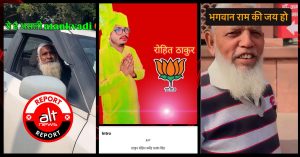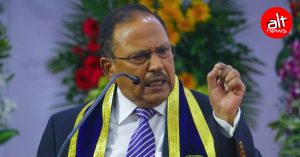Acting on two specific complaints, the News Broadcasting and Digital Standards Authority (NBDSA) has come down heavily on Zee News and Times Now Navbharat over reports on ‘Mehendi Jihad’ and ‘Love Jihad’, respectively. In an order dated September 25, the regulatory body directed Zee News to remove four video reports from its website and YouTube channel within seven days. In another order, it asked Times Now Navbharat to remove objectionable tickers from its reportage.
Zee News on ‘Mehendi Jihad’
Acting on a complaint lodged by activist Indrajeet Ghorpade on bulletins aired by Zee News on October 17, 18, 19, and 20, 2024, the NBDSA ordered the channel to take down four videos within seven days. The direction, however, is yet to be complied with.
In his complaint, Ghorpade alleged that the channel spread anti-Muslim misinformation, claiming that Muslim mehendi artists spat in henna before applying it to Hindu women. The reports further suggested that these artists concealed their Muslim identity to fraudulently marry Hindu women and then coerce them to convert to Islam. It was also alleged that Muslim men worked as mehendi artists to exchange phone numbers with Hindu women with the intent of marriage and forcible conversion.
The complainant alleged that by airing these segments, Zee News amplified violent anti-Muslim rhetoric, including threats to Muslim men, calls for a boycott of Muslim mehendi artists, and slogans promoted by Hindu extremist groups. The channel reportedly failed to fact-check these claims, condemn the threats and abuses against Muslims, or present any opposing viewpoints. In the order, the NBDSA noted that the broadcasts contributed to communal division and fueled anti-Muslim fear and hatred through tickers, thumbnails, and headlines. This, they considered, amounted to violations of the code of ethics and guidelines, including standards on accuracy, neutrality, objectivity, communal harmony, hate speech, and defamation.
During the broadcasts in question, the following tickers, thumbnails, and headlines were aired:
First Broadcast:
-
“Special drive against Mehendi Jihad”
-
“First disclose your identity then apply Mehendi”
-
“Only the one who shows Aadhaar can apply Mehendi”
Second Broadcast:
-
“Mehendi jihad naya fasad”
-
“UP mein naya fasad Mehendi wala Love Jihad”
-
“Pakde jane par sabak sikhaya jayega”
Third Broadcast:
-
“Jihadiyon ke liye lathi taiyar”
-
“Mehendi jihad par de danadan”
-
“Aawedan nivedan nahi mane toh de danadan”
-
“Mehendi jihad ke khilaf lath model launch”
-
“Lathi se lais rahenge jihadiyon ko rokenge”
Fourth Broadcast:
-
“Special drive against Mehendi Jihad”
-
“First disclose your identity then apply Mehendi”
-
“Only the one who shows Aadhaar can apply Mehendi”
Here are a few screenshots from the bulletins:
Zee News’ Response
Zee News defended its ‘Mehendi Jihad’ reports by asserting that its broadcasts merely reported factual developments and statements made by certain Hindu organizations in Western Uttar Pradesh during the Karwa Chauth festival. According to the channel, the reports presented these groups’ calls for Hindu married women to apply mehendi only from Hindu artists and highlighted the establishment of mehendi stalls with identity verification protocols.
Zee News insisted that the contentious term ‘Mehendi Jihad’ was a direct quote from these groups and that its intention was to inform both the public and law enforcement about potential unrest, without endorsing or amplifying any hate speech or misinformation. The channel acknowledged the tickers and headlines reflected third-party statements rather than its own editorial voice and rejected accusations of promoting violence, communal disharmony, or discriminatory practices against Muslim mehndi artists. Emphasising its role as a neutral news provider, Zee News challenged the complaint as a misunderstanding of its objective reporting, underscoring that the segments in question were brief and had to be seen in the broader context of its coverage.
The NBDSA Order
Upon considering the complaint, Zee News’s response, and relevant footage, NBDSA found that Zee News dedicated substantial airtime to the Hindu groups’ perspectives but did not present any viewpoint from those affected, namely the Muslim mehendi artists or government authorities. This omission was held to violate the principle of neutrality under NBDSA’s code of ethics and broadcasting standards.
NBDSA also noted that the tickers and headlines were direct public statements by third parties but were aired without clarifying that they did not represent the broadcaster’s views, potentially misleading the audience.
While acknowledging editorial freedom, NBDSA reminded broadcasters of their responsibility to examine content critically, especially sensitive communal issues, to uphold journalistic standards.
Consequently, NBDSA admonished Zee News for failing to maintain neutrality and directed the channel to be more careful in future broadcasts by ensuring all affected parties’ views are represented. The Authority mandated removal of the contentious videos and their hyperlinks from Zee News’ platforms within seven days and required written confirmation of compliance.
Times Now Navbharat on ‘Love Jihad’
In another complaint, Ghorpade drew the NBDSA’s attention to a broadcast titled “Love Jihad UP News” aired on October 2, 2024 by Times Now Navbharat, the Times Group (Bennett, Coleman & Company Limited)’s Hindi news channel. According to the complaint, the broadcast presented a one-sided and inflammatory narrative on a Bareilly court case without airing critical facts, particularly omitting that the Hindu woman involved claimed she was forced by her parents and Hindu Right-wing groups to file a false FIR accusing her Muslim boyfriend of rape and forced religious conversion. The court had disregarded the woman’s statement of coercion and sentenced the accused to life imprisonment, but the broadcast selectively echoed the court’s judgment without scrutiny or investigation into these conflicting claims.
The bulletin, the complainant alleges, aired statements from multiple BJP politicians that promoted the ‘Love Jihad’ conspiracy theory, using provocative tickers, headlines, visuals, and thumbnails that reinforced negative stereotypes, promoted communal disharmony, and fostered religious hatred. Further, the coverage is alleged to have violated several ethical guidelines, including accuracy, objectivity, neutrality, and respect for religious harmony. Ghorpade also argued that the broadcast deprived viewers of a balanced understanding by omitting the woman’s confession and context, which led to portraying the Muslim accused as definitively criminal despite unresolved factual issues.
Tickers like “Love Jihad ka khel, toh kaatni hogi umra bhar jail” and caricatures that stereotyped Muslims as deceitful and hiding behind Hindu identities were aired during the report.
TNN’s Response
Times Now Navbharat responded to the complaint by asserting that their reportage was based on verified facts and judicial records. They maintained that the broadcast was a factual narration of the court’s judgment, which found the accused Mohammad Alim guilty of coercing a 20-year-old woman to embrace Islam and marry him under pretences. TNN denied that the woman’s statement about coercion by her parents and Hindu Right-wing groups was excluded intentionally, stating these claims were not substantiated or accepted by the court. The channel emphasised that its coverage adhered to responsible journalism standards and did not promote any biased or Islamophobic narrative. TNN also pointed out that including statements from politicians was part of standard journalistic practice.
However, TNN acknowledged that some tickers and visual elements used during the broadcast were provocative but maintained that these were part of the broader narrative and relevant to the public discourse. They stated the broadcast focused on crimes against women and that reporting such judicial findings was in the public interest.
The NBDSA Order
The NBDSA judgement on Times Now Navbharat’s ‘Love Jihad’ coverage focused on the use of provocative tickers and sensational captions that were not part of the court judgment and did not fit the intended subject of the reportage. The Authority noted that while the broadcast of the court’s factual narration itself was not objectionable, the added elements like such as captions like “UP mein Love jihad… toolkit Pakistani” and “Jhuthe naam ka afsana, maksad musalman banana” were problematic and ordered their removal. The NBDSA reminded broadcasters of their responsibility to critically examine content on sensitive issues in line with journalistic standards to maintain balanced and respectful public discourse. It specifically pointed at the lack of clarification that these incendiary tickers represented third-party statements and not the broadcaster’s views.
Not the First Offence for Either Channel
This is not the first time the NBDSA has pulled up Zee News. In November 2021, the regulator ordered the channel to take down three shows that spread misinformation and hatred against farmers. Earlier, in November 2020, Aaj Tak, Zee News, India TV, and News24 were directed to air public apologies for their sensational and unethical coverage of the Sushant Singh Rajput case, after complaints filed by Ghorpade. He later urged the NBDSA to adopt WHO guidelines on suicide reporting, arguing that such token penalties failed to hold the media accountable.
Times Now Navbharat, too, has been reprimanded in the past. In June 2024, the NBDSA directed the channel to remove videos that falsely implied Muslim men were harassing Hindu women, noting that the broadcasts were misleading as none of the interviewed women had made such claims. The regulatory body had then reiterated its advisory to all news channels that video thumbnails must accurately reflect their content. In February 2024, a similar advisory had been issued over misleading visuals and communal insinuations and TNN was fined Rs 1 Lakh by the NBDSA. In November 2020, the NBDSA found a Times Now Navbharat show anchored by Navika Kumar to be in violation of communal harmony guidelines. The programme had baselessly accused Muslim men of harassing Hindu women during Garba events while failing to condemn Bajrang Dal’s violence against them. The regulator cautioned the channel against such reporting and directed it to take down the video within seven days.
Independent journalism that speaks truth to power and is free of corporate and political control is possible only when people start contributing towards the same. Please consider donating towards this endeavour to fight fake news and misinformation.




